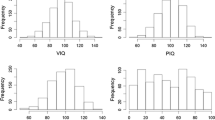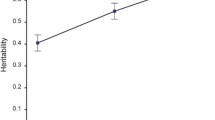Abstract
Monozygotic (MZ) twin pairs with spouses and children, altogether 787 subjects, completed the Jenkins Activity Survey (JAS). The observed correlations for the various sets of relationships fitted well with biometric models including only parameters for additive genetic effects and, for Type A and Job Involvement, assortative mating. There was no evidence of effects of the family environment (cultural transmission) or genetic dominance (nonadditivity). For all but the Hard Driving and Competitive scale, there was evidence of effects of sex-specific genes. The heritability estimates were, for males and females, respectively, .33 and .39 for Type A, .36 and .48 for Job Involvement, .20 and .52 for Speed and Impatience, and .13 (both sexes) for Hard Driving and Competitive. The estimates given here are deflated by measurement errors and should probably be corrected by multiplying by values in the neighborhood of 1.3. Even after correction, the results suggest that individual differences for Type A and related traits depend more on nonfamilial environment than on genes.
Similar content being viewed by others
References
Abbot, A. V., Peters, R. K., and Vogel, M. E. (1988). Temporal stability and overlap of behavioral and questionnaire assessments of type A behavior in coronary patients.Psychosom. Med. 50:123–138.
Akaike, H. (1970). Statistical predictor identification.Ann. Inst. Stat. Math. 21:243–247.
Bortner, R. W., Rosenman, R. H., and Friedman, M. (1970). Family similarity in pattern A behavior.J. Chron. Dis. 23:39–43.
Carmelli, D., Rosenman, R. H., and Chesney, M. A. (1987). Stability of the type A structured interview and related questionnaires in a 10-year follow-up of an adult cohort of twins.J. Behav. Med. 10:513–525.
Carmelli, D., Rosenman, R., Chesney, M., Fabsitz, R., Lee, M., and Borhani, N. (1988a). Genetic heritability and shared environmental influence of type A measures in the NHLBI Twin Study.Am. J. Epidemiol. 127:1041–1052.
Carmelli, D., Rosenman, M. D., and Swan, G. E. (1988b). The Cook and Medley HO Scale: A heritability analysis of adult male twins.Psychosom. Med. 50:165–174.
Cloninger, C. R. (1980). Interpretation of intrinsic and extrinsic structural relations by path analysis: Theory and applications to assortative mating.Genet. Res. 36:135–145.
Eaves, L. J., Eysenck, H. J., and Martin, N. G. (1989).Genes, Culture and Personality; Academic Press, London.
Eysenck, H., and Fulker, D. (1983). The components of type A behavior and its genetic determinants.Personal. Individ. Diff. 4:499–505.
Freeman, Z. (1986). Is type A behavior a cause of coronary heart disease?Med. J. Austral. 145:262–270.
Jenkins, C. D., Rosenman, R. H., and Zyzanski, S. J. (1974). Prediction of clinical coronary heart disease by a test for the coronary-prone behavior pattern.N. Engl. J. Med. 290:1271–1275.
Jenkins, C. D., Zyzanski, S. J., and Rosenman, R. H. (1979).Jenkins Activity Survey Manual; Psychological Corp., New York.
Koskenvuo, M., Kaprio, J., Langinvainio, H., Romo, M., and Sarna, S. (1981). Coronary-prone behavior in adult same-sexed male twins: An epidemiology study. In Gedda, L., Parisi, P., and Nance, W. E. (eds.),Twin Research 3: Epidemiological and Clinical Studies, Alan R. Liss, New York, pp. 139–148.
Lange K. L., Westlake, J., and Spence, M. A. (1976). Extension to pedigree analysis. III. Variance components by the scoring method.Annu. Hum. Genet. 39:485–491.
Lykken, D. T., McGue, M., and Tellegen, A. (1987). Recruitment bias in twin research: The rule of two-thirds reconsidered.Behav. Genet. 17:343–362.
Magnus, P., Berg, K., and Nance, W. E. (1983). Predicting zygosity in Norwegian twin pairs born 1915–1960.Clin. Genet. 24:103–112.
Martin, N. G., and Wilson, S. R. (1983). Bias in the estimation of heritability from truncated samples of twins.Behav. Genet. 12:467–472.
Matthews, K. A. (1983). Origins of the type A (coronary prone) behavior pattern.J. So. Carolina Med. Assoc. 79:551–556.
Matthews, K. A., and Krantz, D. S. (1976). Resemblance of twins and their parents in pattern A behavior.Psychosom. Med. 38:140–144.
Matthews, K. A., Rosenman, R. H., Dembroski, T. M., Harris, E. L., and MacDougall, J. M. (1984). Familial resemblance in components of the type A behavior pattern: A reanalysis of the California Type A Twin Study.Psychosom. Med. 46:512–521.
McGue, M., Wette, R., and Rao, D. C. (1984). Evaluation of path analysis through computer simulation: Effect of incorrectly assuming independent distributions of familial correlations.Genet. Epidemiol. 1:255–270.
Pedersen, N. L., Lichtenstein, P., Plomin, R., DeFaire, U., McClearn, G. E., and Matthews, K. A. (1989). Genetic and environmental influence for type A-like measures and related traits: A study of twins reared apart and twins reared together.Psychosom. Med. 51:428–440.
Rahe, R. H., Hervig, L., and Rosenman, R. H. (1978). Heritability of type A behavior.Psychosomatic Medicine,40, 478–486.
Reed, T., Carmelli, D., and Rosenman, R. H. (1991). Effects of placentation on selected type A behaviors in adult males in the National Heart, Lung, and Blood Institute (NHLBI) Twin Study.Behav. Genet. 21:9–19.
Rose, R. J., and Kaprio, J. (1988). Frequency of social contact and intrapair resemblance of adult monozygotic cotwins—Or does shared experience influence personality after all.Behav. Genet. 18:309–328.
Sweda, M. G., Sines, J. O., Lauer, R. M., and Clarke, W. R. (1986). Familial aggregation of type A behavior.J. Behav. Med. 9:23–32.
Tambs, K., and Sundet, J. M. (1985). Arv og miljø i utdannelse. Effkten av gener og miljø på forskjeller i utdannelse, intelligens, yrkesstatus og prestasjonsmotivering estimert ved en tvillingundersøkelse.Tidsskrift for Samfunnsforskning 26;437–456.
Tambs, K., Sundet, J. M., and Berg, K. (1987). Cotwin closeness in monozygotic and dizygotic twins: A biasing factor in IQ heritability analysis?Acta Genet. Med. Gemellol. 34:33–39.
Tambs, K., Sundet, J. M., Eaves, L. J., and Bergs, K. (1989). Relations between EPQ and Jenkins Activity Survey.Personality and Individual Differences,12:1229–1235.
Tambs, K., Sundet, J. M., Eaves, L. J., Solaas, M. H., and Berg, K. (1991). Pedigree analysis of EPQ scores in MZ twin families.Behav. Genet. 21:369–382.
Truett, K. R., Eaves, L. J., Heath, A. C., Hewitt, J. K., Meyer, J. M., Silberg, J., Neale, M. C., Martin, N. G., Walters, E. E., and Kendler, K. S. (1992). A model system for analysis of family resemblance in extended kinships of twins (in preparation).
Author information
Authors and Affiliations
Rights and permissions
About this article
Cite this article
Tambs, K., Sundet, J.M., Eaves, L. et al. Genetic and environmental effects on Type A scores in monozygotic twin families. Behav Genet 22, 499–513 (1992). https://doi.org/10.1007/BF01066618
Received:
Accepted:
Issue Date:
DOI: https://doi.org/10.1007/BF01066618




